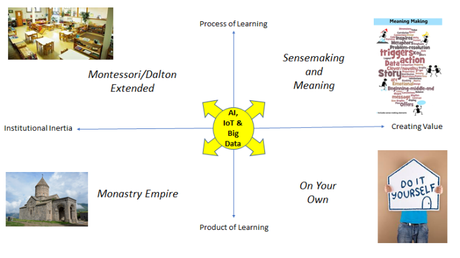In "Education - 21 Century Challenges" about "What should we teach children?" we posed two additional questions:
What advice should young people follow?
Who or where should they turn for advice when adults' wisdom may only be outdated biases?
We suggested two (visual) approaches; one that departs from the current situation and one that departs from 2050. We began by exploring exploring Quintessentially Me - Student 2050, followed by Your Face as a Student 2018. Confronting these two, rather intuitive, opposite approaches, what are the similarities and differences? Are they revealing uncertainties and points of resistance? Can we identify drivers of trends? Can we define some possible educational future worlds?
Put the dominant uncertainties on a list, take some time to reflect on it. Then, cluster the list down to 2 relative independent uncertainties or contradictions. Then, build a scenario matrix.

1. nnovation in the product of learning vs change in the process of learning /importance of curiosity, independent thinking, and imagination/ Attitudes and use of tests based on averages vs demonstration of skills and knowledge/
2.stitutional inertia vs personal value creation/ lack of time to make changes - dedication to spend time on educational innovation/ teachers are resisting changes - vs embracing educational innovation/ Window dressing vs. critical analysis of the school system/ Predetermined skills vs choice of what to study and learn/ power of society to determine what is taught /mass instruction vs individual programs designed by the student
Key driver: the impact of AI, Big Data and IoTNow, put some eye-catching names on the future worlds and give a short description that relates to the key driving forces
Our efforts:World 1 has made available a highly for individuals designed educational ecosystem, both in terms of knowledge, skills and talent as well as in learning attitudes, abilities and styles. It is aimed at creating value and making sense as a counterweight to depersonalization as a result of the far-reaching integration of IoT, Big Data and AI. This world we call Sense-Making and Meaning.
World 2 is still bases of the medieval concept of schools and universities, however, there are made great development steps in didactics, like small group work, blended learning, fewer facts and more concepts, etc. We call it Montessori/Dalton Extended. World 4 offers an educational system for highly individual based choices. Students can pick classes at what schools and disciplines they like. There is a heavy use of Massive Open Online Courses like the Khan Academy. This world we call On Your Own.World 3 is the world as we have known it for the last 500 years, but more perfected. The only things that changes that take place are a continuing process of diversification of knowledge and adapting to new technology. We called this world The Monastery Empire.

Add for each world a short description. Use the map for trend watching and planning action steps. To make an inventory of emerging initiatives. Or to answer questions like "What advice should young people follow?" or "Who or where should they turn for advice when adults' wisdom may only be outdated biases?'. The answers depend, of course, from the world you are expecting to be in.
This is the end of the series about 21 Challenges for 21 Century: Education, based on the book by Yuval Noah Harari in the book 21 Lessons for the 21st Century (see the blog post Will our inventions make us irrelevant?)..
We will continue with the challenge on knowledge illusion: the uncomfortable feeling that it is too much and you simply cannot understand it all.
